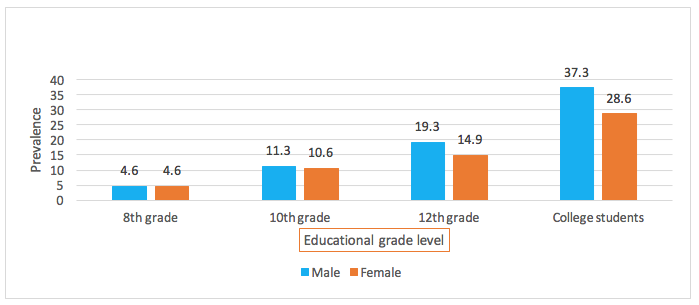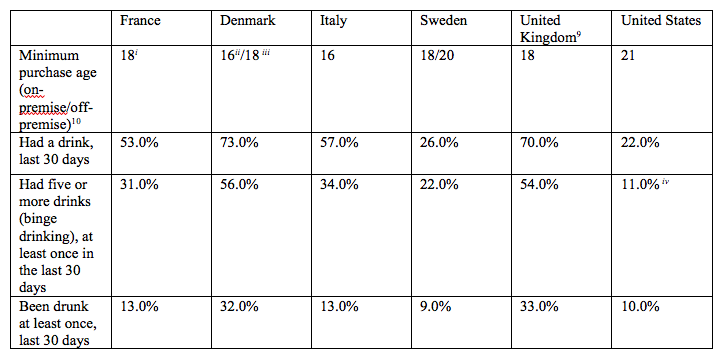Prevalence of Underage Drinking
- In 2015, approximately 7.7 million people ages 12 to 20 reported drinking alcohol in the past month. Five million (13.4%) were current i.e. past month, binge drinkers; and 1.3 million (3.3%) were heavy drinkers.1
- In 2015, an estimated 2.4 million young people aged 12 to 17 used alcohol for the first time, an average of approximately 6,500 new initiates every day.2
- Even though it is illegal for underage youth to purchase alcoholic beverages, they have had substantial experience with alcohol.3
Prevalence of drinking by grade level in 2015:3,4,5

* Young adults are high school graduates with modal ages 19 to 28. This includes the college student population.4
- Binge drinking (consuming 5 or more drinks in a row) at least once in the two-week period preceding a 2015 survey was reported by 4.6% of 8th graders, 11.0% of 10th graders, 17.0% of 12th graders, 32.0% of college students, and 32.0% of young adults.3,4
- At 32%, college students continue to stand out as having a relatively high level of binge drinking.3
- The two-week prevalence for 12th grade students who reported “extreme binge drinking” (consuming 10 or more drinks in a row, or 15 or more drinks in a row on a single occasion), was 0.3% in 2015.3
- More than half of students in 8th, 10th, and 12th grades who had consumed 5 or more drinks in a row, did so more than once in the two-week period preceding a 2015 national survey in the U.S.3
- Similarly, more than half of 12th grade students who reported “extreme binge drinking”, did so more than once in the two-week period preceding a 2015 national survey in the U.S.3
Two-week prevalence of binge drinking by educational grade level in 2015 (%):3

- More youth in the United States drink alcohol than smoke tobacco, marijuana or other illicit substances, making it the drug most widely used by young people.5
- In 2015, a higher percentage of youth used alcohol than tobacco or illicit drugs in the past month in the following age categories surveyed; 12 to 17, 18 to 25, and 26 or older.6
In 2015, more youths used alcohol than tobacco or illicit drugs in the past month:6

In 2015, more middle and high school students used alcohol than cigarettes:3, 5

30-day prevalence of being drunk by gender, in 2015:7

Many people assume that European countries, with lower drinking ages, are more successful than the U.S. at preventing heavy drinking among young people. However, surveys from those countries that are designed to be comparable with U.S. data suggest otherwise:
Drinking among 15-16-year-old students, selected Western countries and United States, 20158

i Buying alcohol is illegal below the age of 18 for spirits and below 16 for other beverages.
ii Alcohol By Volume (ABV) must be above 1.2% and below 16.5% to purchase in shops at age 16.
iii Alcohol By Volume (ABV) must be above 16.5% to purchase in shops at age 18.
iv Limited comparability. Binge drinking prevalence in the United States is measured in “past 2 weeks”.
Updated March 2017
Prevalence of Underage Drinking (printer-friendly version)
Notes
1. Substance Abuse and Mental Health Services Administration. Report to Congress on the Prevention and Reduction of Underage drinking. Washington, DC; June 11, 2015.
2. Lipari, R. N., Williams, M. R., Copello, E. A. P., & Pemberton, M. R. (2016). Results from the 2015 National Survey on Drug Use and Health. SAMHSA/NSDUH Data Review.
3. Miech, R. A., Johnston, L. D., O’Malley, P. M., Bachman, J. G., & Schulenberg, J. E. (2016). Monitoring the Future national survey results on drug use, 1975–2015: Volume I, Secondary school students. Ann Arbor: Institute for Social Research, The University of Michigan. Available at http://monitoringthefuture.org/pubs.html#monographs.
4. Johnston, L. D., O’Malley, P. M., Bachman, J. G., Schulenberg, J. E. & Miech, R. A. (2016). Monitoring the Future national survey results on drug use, 1975–2015: Volume 2, College students and adults ages 19–55. Ann Arbor: Institute for Social Research, The University of Michigan. Available at http://monitoringthefuture.org/pubs.html#monographs.
5. Johnston, L. D., O’Malley, P. M., Miech, R. A., Bachman, J. G., & Schulenberg, J. E. (2016).
Monitoring the Future national survey results on drug use, 1975-2015: Overview, key findings on adolescent drug use. Ann Arbor: Institute for Social Research, The University of Michigan.
6. Center for Behavioral Health Statistics and Quality. (2016). Key substance use and mental health indicators in the United States: Results from the 2015 National Survey on Drug Use and Health (HHS Publication No. SMA 16-4984, NSDUH Series H-51). Retrieved from http://www.samhsa.gov/data/
7. Johnston, L. D., O’Malley, P. M., Miech, R. A., Bachman, J. G., & Schulenberg, J. E. (2016). Demographic subgroup trends among adolescents in the use of various licit and illicit drugs, 1975–2015 (Monitoring the Future Occasional Paper No. 86). Ann Arbor, MI: Institute for Social Research, The University of Michigan. Available at http://monitoringthefuture.org/pubs.html#papers.
8. Except for minimum purchase age, Hibell, B., Guttormsson, U., Ahlstrom, S., Balakiereva, O., Bjarnason, T., et al. ESPAD Report 2015: Results from the European School Survey Project on Alcohol and other Drugs. (European Monitoring Centre for Drugs and Drug Addiction, 2016). (Accessed at http://www.espad.org/sites/espad.org/files/ESPAD_report_2015.pdf on October 24, 2016).
9. The 2007 ESPAD Report: Substance Use Among Students in 35 European Countries. (Stockholm: The Swedish Council for Information on Alcohol and Other Drugs [CAN], 2009). (Accessed at http://www.espad.org/espad-reports on October 24, 2016).
10. Wikipedia. Accessed at http://en.wikipedia.org/wiki/Legal_drinking_age on October 24, 2016.